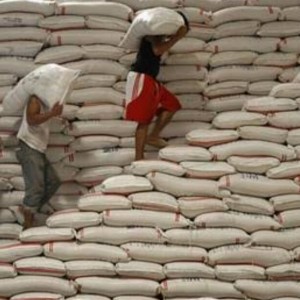There is an important lesson in the alleged “massacre” of hungry farmers in Kidapawan, North Cotabato during an allegedly “violent” dispersal of a protest rally there. The lesson is that it is easy for a sitting president to be blamed for “atrocities” allegedly committed by the police and the military. Why is this an important lesson? Because the Kidapawan incident has highlighted the fundamental flaw in the arguments coming from all political camps surrounding what constitutes an “evil” and “oppressive” regime.

The Kidapawan massacre was really just supposed to be all about rice.
Indeed, the same shrill voices of indignation being raised from a who’s-who of social media “activists” in the days following this so-called “massacre” echoes the same shrill voices of indignation that characterise the “Never Again” movement that demonises former President Ferdinand Marcos for alleged “atrocities” he supposedly masterminded during his supposedly “brutal” Martial Law “regime”.
It is quite ironic that we now find the Yellow mob of President Benigno Simeon “BS” Aquino pleading plausible deniability on behalf of the sitting president (presumably to save the dead-in-the-water candidacy of Liberal Party bet Mar Roxas). It is, one cannot emphasise enough, the very same argument that people in the Marcos camp, themselves, assert that Marcos, during his rule, had no way of exercising direct control over all armed state services and, therefore, cannot be held accountable for all of the alleged atrocities his so-called “victims” are shrieking about.
Funny, indeed, how minions’ perspectives change when one is in power.
As for those who are quick to cry bloody murder on behalf of the massacre victims, the mere existence of “outrage” is no excuse to be making shrill pronouncements on the back of unreliable information.
There are only two key sources of information on what happened in Kidapawan — the account of the police and the account of the organisers (or shall we say, incitors. Flawed (at best) and crooked (at alleged worst) the Philippine National Police (PNP) may be, there is, at least, some science in the methods they apply to investigating incidents the results of which are, in turn, subject to institutional checks-and-balances. Their competing source of “information” on Kidapawan are the accounts of the infiltrators of the 1st April farmers’ protest rally — the communist lackeys in the all-too-familiar cast of characters, Anakpawis, the Kilusang Mayo Uno (KMU), and so-called “womens’ issues” advocate Gabriela. These groups, in contrast, do not apply a systematic method in the way they arrive at their conclusions, are not held accountable to the accuracy of their published communications, nor are their operations subject to scrutiny and inquiry by third parties. They are also known anarchists and apply a violent ideology to most of their social “causes”.
Nobody disagrees that there is a “high level of moral outrage” inherent in this incident. But (1) having a penchant for acting on feelings and (2) having the intellectual discipline and honesty to systematically think through an issue is what sets aside the men from the boys — or, in that regard, the men from the girlie “activists” who infest the fashionable chatter of the week.
Indeed, one account of the incident published by Business World Online relates the plight of a police officer critically injured by members of the protesting mob in Kidawan…
KIDAPAWAN CITY — Rosalie Ann Untalan sat in a corner outside the intensive care unit (ICU) of the Kidapawan Doctors, Inc., on Saturday afternoon, waiting for news on the condition of her husband, SPO2 Ricky Untalan of M’lang Police Station.Ms. Untalan, a teacher who also works as secretary to the president of the Southern Baptist College here, told reporters on Saturday that every 20 minutes she goes inside the ICU to check on her husband, who had been fighting for his life since he was rushed to the hospital last Friday.A video footage taken by a drone camera of the City Government of Kidapawan showed her husband was left behind when the police line was broken by angry protesters who returned after having been initially dispersed by water cannons. Alone amidst the protesters, he was beaten up.Ms. Untalan said her husband’s head was “damaged” and he has not opened his eyes yet.
There is also evidence that gunfire was not a one-way affair in favour of the police on that fateful day…
According to a statement of Chief Supt. Wilben M. Mayor, spokesperson of the Philippine National Police, another police officer, PO2 Reynaldo Roque, sustained a gunshot wound in his left leg. Mr. Roque is currently confined at the Kidapawan Doctors’ Hospital.
Consistent with this account, a PNP Scene of Crime Operations (SOCO) report released earlier revealed evidence that some of the rallyists may, indeed, have discharged firearms in the heat of the melee.
Quite interesting then that the very same social media shills who expressed noisy outrage over the massacre of 44 PNP Special Action Force officers by elements of the terrorist Moro Islamic Liberation Front back in 2015 now paint the police as savage brutes who shoot to kill protesting “farmers”. Yet herein is proof that these “farmers” are not that innocent after all; evidently, themselves, all-too-capable of the very same brutality Filipino cops are routinely accused of.
Again, the lesson here needs to be highlighted: that the Philippines, as a society, needs to transform into a thinking society. This is important to ensure that the right questions are asked whenever crises like these erupt and, as an outcome, the right arguments prevail. The alternative is for Filipinos to remain the same intellectually bankrupt people that they are — which will be a monumental tragedy considering that the power to select leaders had long ago been thrust upon them.

No comments:
Post a Comment